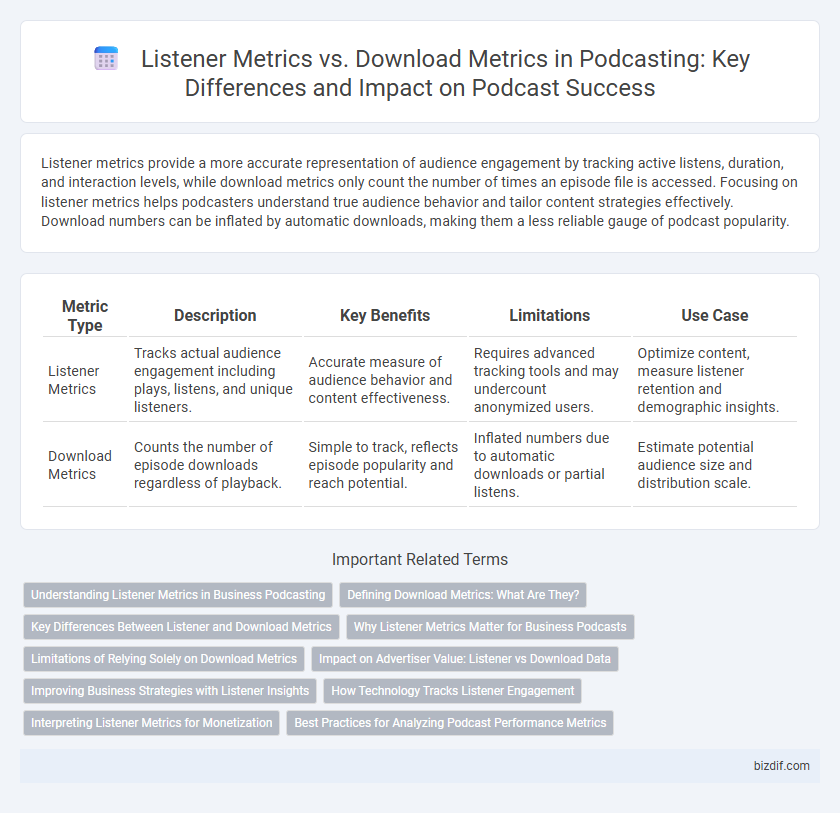Listener metrics provide a more accurate representation of audience engagement by tracking active listens, duration, and interaction levels, while download metrics only count the number of times an episode file is accessed. Focusing on listener metrics helps podcasters understand true audience behavior and tailor content strategies effectively. Download numbers can be inflated by automatic downloads, making them a less reliable gauge of podcast popularity.
Table of Comparison
| Metric Type | Description | Key Benefits | Limitations | Use Case |
|---|---|---|---|---|
| Listener Metrics | Tracks actual audience engagement including plays, listens, and unique listeners. | Accurate measure of audience behavior and content effectiveness. | Requires advanced tracking tools and may undercount anonymized users. | Optimize content, measure listener retention and demographic insights. |
| Download Metrics | Counts the number of episode downloads regardless of playback. | Simple to track, reflects episode popularity and reach potential. | Inflated numbers due to automatic downloads or partial listens. | Estimate potential audience size and distribution scale. |
Understanding Listener Metrics in Business Podcasting
Listener metrics in business podcasting provide a deeper understanding of audience engagement by tracking active listens, listening duration, and episode completion rates. Unlike download metrics, which only measure the number of times an episode is downloaded, listener metrics reveal how and when content is consumed, offering actionable insights for optimizing marketing strategies and content development. Accurate listener data helps businesses tailor their messaging, increase audience retention, and demonstrate podcast ROI more effectively.
Defining Download Metrics: What Are They?
Download metrics in podcasting quantify the total number of times an episode file is retrieved from a server, providing a raw measure of content distribution reach. These metrics capture absolute download counts without indicating if the episode was listened to, skipped, or partially played. Podcast creators leverage download data to gauge episode popularity trends, advertising potential, and to benchmark growth over time within various distribution platforms.
Key Differences Between Listener and Download Metrics
Listener metrics measure the actual number of unique individuals engaging with podcast content, offering insights into audience behavior and episode popularity. Download metrics count every file downloaded, regardless of whether it was listened to, potentially inflating audience size estimates. Understanding these key differences helps podcasters make informed decisions for advertising, content strategy, and audience growth.
Why Listener Metrics Matter for Business Podcasts
Listener metrics provide a more accurate representation of audience engagement than download metrics by tracking actual listens instead of mere file downloads. For business podcasts, understanding listener behavior helps tailor content strategy, improve targeting, and measure true ROI. Accurate listener data enables companies to optimize marketing efforts, increase sponsorship value, and enhance customer insights effectively.
Limitations of Relying Solely on Download Metrics
Download metrics often overestimate a podcast's actual audience because they count every episode downloaded, regardless of whether it is fully listened to or even played. These metrics fail to capture listener engagement, such as listening duration, completion rates, and repeat listens, which are critical for understanding true audience behavior. Relying solely on download numbers can mislead advertisers and creators, limiting the ability to measure podcast success and optimize content effectively.
Impact on Advertiser Value: Listener vs Download Data
Advertiser value in podcasting hinges significantly on the reliability of listener metrics compared to download data, as listener metrics provide a more accurate reflection of audience engagement and ad exposure. Download metrics can inflate perceived reach since not all downloads equate to completed listens or ad impressions, reducing the precision for advertisers assessing ROI. Brands prioritize campaigns where listener data validates actual consumption, driving more effective ad targeting and improved campaign performance measurement.
Improving Business Strategies with Listener Insights
Listener metrics provide deeper insights into audience engagement compared to download metrics, revealing behaviors such as listening duration, drop-off points, and episode preferences. Leveraging these data allows businesses to tailor content strategies, optimize marketing efforts, and enhance advertiser targeting for increased monetization. Accurate listener insights drive more informed decisions that improve retention rates and boost overall podcast growth.
How Technology Tracks Listener Engagement
Technology tracks listener engagement by analyzing real-time data such as play duration, listener drop-off points, and interaction rates rather than relying solely on download metrics. Advanced analytics platforms use dynamic tracking tools, including embedded podcast players and server-side analytics, to measure actual listener behavior and demographic insights. This approach provides podcasters with accurate metrics on audience retention and engagement, enabling more effective content optimization and targeted advertising strategies.
Interpreting Listener Metrics for Monetization
Listener metrics provide deeper insights into audience engagement by measuring active listens, session duration, and listener retention rates compared to raw download metrics that only indicate the number of files distributed. Interpreting these metrics enables podcasters to demonstrate authentic audience size and engagement levels to advertisers, increasing opportunities for targeted sponsorships and higher ad revenues. Accurate listener data supports dynamic ad insertion strategies and helps optimize content for sustained listener growth and monetization.
Best Practices for Analyzing Podcast Performance Metrics
Listener metrics provide a more accurate representation of audience engagement than download metrics, capturing data such as completion rates, listener demographics, and listening platforms. Best practices for analyzing podcast performance metrics involve combining listener behavior insights with download trends to identify top-performing episodes and optimize content strategy. Utilizing analytics tools that track unique listeners and engagement duration offers actionable data to enhance listener retention and growth.
Listener metrics vs download metrics Infographic

 bizdif.com
bizdif.com